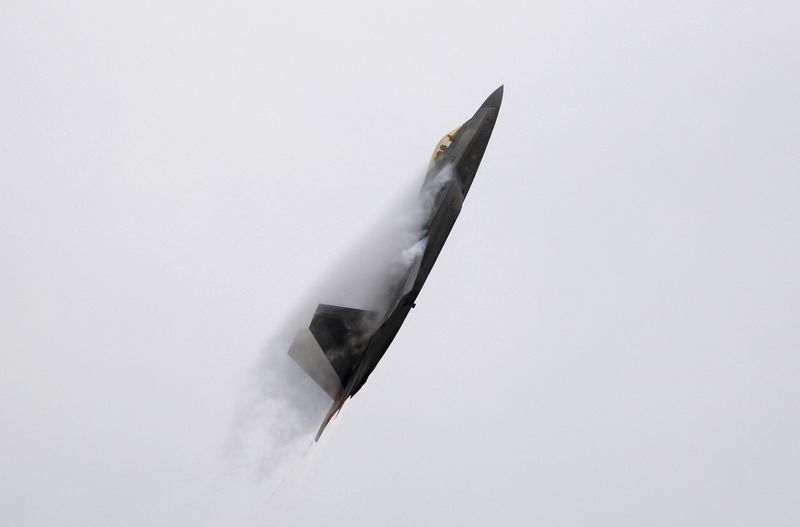By Mike Stone
WASHINGTON (Reuters) - The U.S. Air Force's ambitious next-generation fighter jet program, envisioned as a revolutionary leap in technology, could become less ambitious as budget pressure, competing priorities and changing goals compel a rethink, defense officials and industry executives said.
Initially conceived as a "family of systems" centered around a sixth-generation fighter jet, the Next Generation Air Dominance (NGAD) program is meant to replace the F-22 Raptor and give the United States the most powerful weaponry in the sky well into the mid-21st century.
When it was first proposed, expectations were high, including an unmatched stealth capability to keep it invisible from even the most sophisticated radar, laser weapons and onboard artificial intelligence to process masses of data coming from the latest in sensor technology.
However, sources said the current development budget of $28.5 billion over five years ending in 2029 could be spread out over more time or scaled-back as the Pentagon searches for a cost-effective solution.
Sources briefed on the Air Force's internal budget deliberations said the anticipated 2026 fiscal-year NGAD budget of $3.1 billion would be slashed as funding shrinks, with one source adding that diminishing funds could stretch development by two more years.
While it is unclear how much the overall program will cost, it could eventually total well over $100 billion if 200 aircraft are produced, including initial costs - plus maintenance and upgrades over time. There are currently 185 F-22s in service - the plane NGAD is meant to replace.
The Air Force is also reviewing the concept for the jet - perhaps moving to a larger single-engine jet, from what is believed to be a two-engine design, or even shifting more funding to a less expensive unmanned drone to best address future air superiority needs given the potential budget cuts, industry experts said.
"NGAD was conceived before a number of things: before the threat became so severe, before CCAs (drone program) were introduced into the equation and before we had some issues with affordability that we are currently facing," Air Force Secretary Frank Kendall said on Saturday at Britain's Royal International Air Tattoo, the world's largest military air show.
"Before we commit to the 2026 budget, we want to be sure we are on the right path," he added on a program that will be a popular talking point at the Farnborough International Airshow this week.
The shift in focus comes as the Air Force grapples with substantial cost overruns in several vital, and expensive, programs. For example, its Sentinel intercontinental ballistic missile (ICBM) program, which is set to replace the aging Minuteman III missiles, has ballooned 81% over budget, to around $141 billion.
Budget pressure has forced the Air Force to reassess its spending priorities across various modernization efforts which also include increasing production of the new B-21 bomber made by Northrop Grumman (NYSE:NOC).
U.S. aerospace and defense companies Lockheed Martin (NYSE:LMT) and Boeing (NYSE:BA) have responded to the Air Force's request for proposal for the NGAD system, sources told Reuters.
While defense firms are not exactly desperate for orders with conflicts in Ukraine and Israel driving already-strong demand, NGAD was one of several potentially giant programs many hoped would feed the bottom line in the years ahead.
An Air Force spokesperson told Reuters the department is currently building its fiscal 2026 budget which will be released early next year. Representatives for Boeing did not return requests for comment. Lockheed would not comment on NGAD.
"The part that seems to be getting stalled and re-evaluated is the air vehicle itself, the central platform," said J.J. Gertler, a senior analyst at aerospace and defense analysis firm the Teal Group.
"The Air Force is now making sure that that's what they actually want and possibly changing their mind," he added.
Possible new configurations might be shifting to a single engine for the jet to save on up-front cost and long-term maintenance. Twin-engine jets are much more expensive to buy and operate, but they are more dependable and faster, therefore more deadly in a dogfight than their single-engine foes.
Another key component emerging from this restructuring is the possibility of shifting funds toward the unmanned fighter drone known as the Collaborative Combat Aircraft initiative.

Development of the less expensive drone platforms, designed to operate alongside the main jet, does not face budget changes.
(This story has been refiled to correct the dateline)